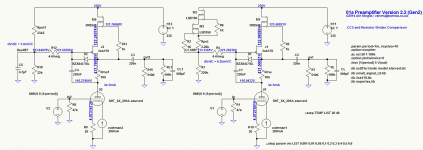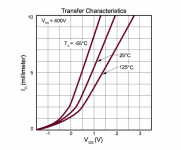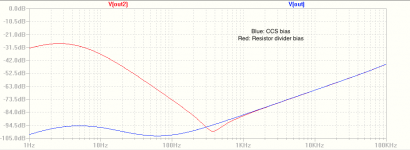The simulation is difficult to control because the DRAIN-SOURCE voltage on the bottom device - U4- is small and hard to predict, since it is contrlled by the gate-source voltage of the UPPER device.
Are you connecting a triode for a load, or 3.3K? If 3.3K beware that this means 55mA when the voltage is 180V, and 4W burn in the upper device. (hope you have a heatsink!)
TBH, it would be much easier to add the zeners, as I have suggested, and measure the results, rather than worry about the sim.
Yes I have a huge heaksink on the upper DN2540 so okay here...
I don't have any Zener yet.
Rod is the lower DN2540 the only FET I need to protect with Zener ???
Yes Michael. If you do a step test with a resistor load you will likely exceed the VGS max and kill the lower FET. It will go short hence the result you're getting I think. The protection Zener is needed unless the circuit is properly loaded. Best to have the Zener!
Yes Michael. If you do a step test with a resistor load you will likely exceed the VGS max and kill the lower FET. It will go short hence the result you're getting I think. The protection Zener is needed unless the circuit is properly loaded. Best to have the Zener!
Hi Ale.
I tried the resistor load only because it works on my old gyrator CCS with
only a couple of DN2540.
I have ordered some Zener to protect the lower DN2540 as Rod explained in a previous post.
When I have the Zener I'll add them, and first try a resistor load using a
6.8K as load.
So another try, when I got the Zener diodes.
Big thanks to you and Rod.
/Michael.
In other words never leave the gyrator unloaded and then connect the load when is powered.
I always has some kind of load before applying power.
Is the reason it works with a tube that it start up slow, in contrast to a
resistor load ??
Hi Rod and Ale.
Thanks for your great help, up I'm up running on one side now.
@Rod. Yes you have absolute right when I added the Zener my resistor test was save. I'm have then on as a precaution. I had added 15v Zener and it works.
@Ale. Thanks for this improvement. I'm on a 1K as anode load resistor and I
can definitely hear more clarity in my sound from the 4P1L.
@Spice. Simulation is not right anymore. Real life is quite different.
@picture.
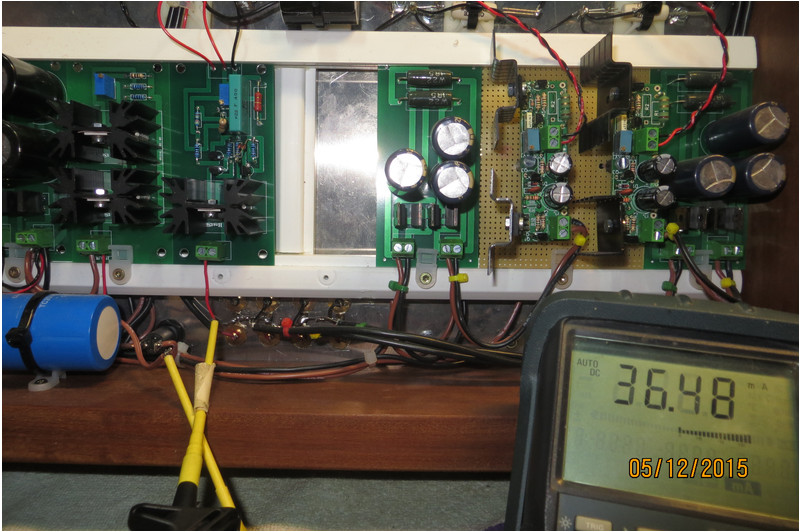
I can adjust the current from 21.36 mA to 36.48 mA with my trimmer 1K in serie with a 300R resistor...
Building the other side right now..
/Michael.
Thanks for your great help, up I'm up running on one side now.
@Rod. Yes you have absolute right when I added the Zener my resistor test was save. I'm have then on as a precaution. I had added 15v Zener and it works.
@Ale. Thanks for this improvement. I'm on a 1K as anode load resistor and I
can definitely hear more clarity in my sound from the 4P1L.
@Spice. Simulation is not right anymore. Real life is quite different.
@picture.

I can adjust the current from 21.36 mA to 36.48 mA with my trimmer 1K in serie with a 300R resistor...
Building the other side right now..
/Michael.
Hi Michael. It would be useful if you post the complete schematic when you have it working properly.
Hi Michael. It would be useful if you post the complete schematic when you have it working properly.
Hi Andy...
It is working properly now. Listening to it and it's definitely better than
my old simple one.
I only have some very few things different than Ale.
Zener diodes 15volt across the lower DN2540. If not you'll damage it
if you try with a resistor load.
4.3M resistor instead of the 4.7M.
1K as anode load instead of 470R.
Trimmer is 1K instead of 2K.
I'm still on 8R cathode here we go.
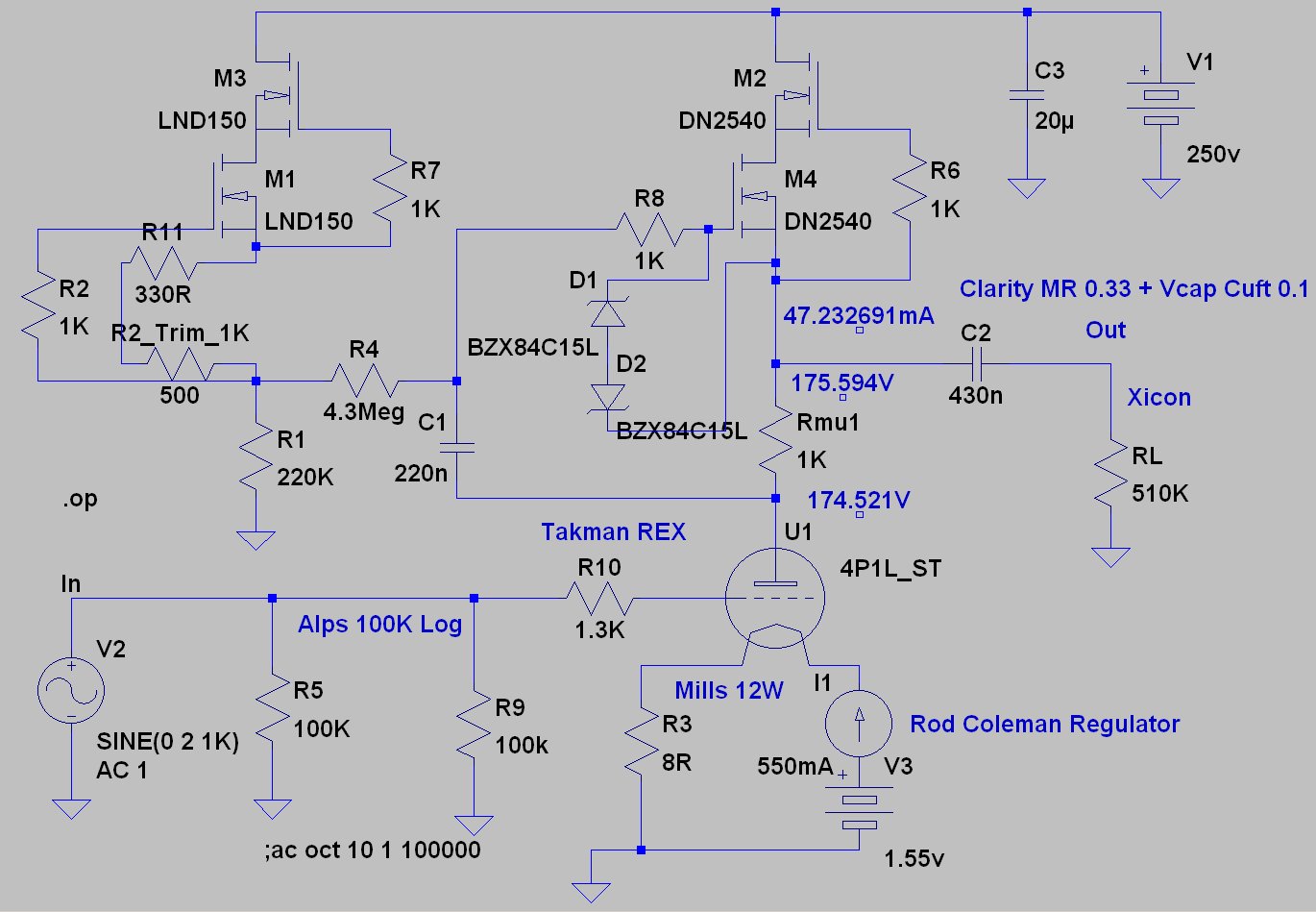
PS! Please ignore the voltage,wattage,amps values on the schematic. Lt-Spice does not work properly anymore..
On my 8R 1 have 1.55volt on the filament and 108volt on the anode. Which equals 30mA. I can adjust from 21.36 mA to 36.48 mA on my trimmer. Lower the R11 330R with of course raise the current.
/Michael
I have a question about the gyrator. I am thinking I misunderstand its operation, so for clarification....
The dual LND150's are current sources feeding the 220k resistor for setting the anode voltage? Up to this point I have perhaps made the mistake that they are simply a Vref for the dual dn2540.
The dual LND150's are current sources feeding the 220k resistor for setting the anode voltage? Up to this point I have perhaps made the mistake that they are simply a Vref for the dual dn2540.
Hi buzzforb,
The LND150 cascoded pair forms an CCS which sets the reference voltage across R1. By having a CCS there increases the reflected impedance which you can see looking from C1 and R4 hence the frequency response is better.
Ale
The LND150 cascoded pair forms an CCS which sets the reference voltage across R1. By having a CCS there increases the reflected impedance which you can see looking from C1 and R4 hence the frequency response is better.
Ale
Hi Rod and Ale.
Thanks for your great help, up I'm up running on one side now.
@Rod. Yes you have absolute right when I added the Zener my resistor test was save. I'm have then on as a precaution. I had added 15v Zener and it works.
@Ale. Thanks for this improvement. I'm on a 1K as anode load resistor and I
can definitely hear more clarity in my sound from the 4P1L.
@Spice. Simulation is not right anymore. Real life is quite different.
@picture.

I can adjust the current from 21.36 mA to 36.48 mA with my trimmer 1K in serie with a 300R resistor...
Building the other side right now..
/Michael.
Hi Michael,
great to hear you managed to get it working. I'd always suggest to use a Variac to test this type of circuits as you would avoid killing the FETs that way. Now you have the protection zener it should be ok
This circuit sounds great, I have always loved the sound of the gyrator with the 4P1L for many years. Enjoy!
Ale
Ok. That was the impression I had. I assume it helps determine the bias of the Dn2540 pair, needing to be set for a slightly lower voltage than the source voltage of the lower DN2540?
Hi buzzforb,
The LND150 cascoded pair forms an CCS which sets the reference voltage across R1. By having a CCS there increases the reflected impedance which you can see looking from C1 and R4 hence the frequency response is better.
Ale
I would use a resistive voltage divider shunted by a cap, to set a fraction of B+ instead of a constant temperature dependent voltage.
Hi Analtoliy,
I've tried both options and I'd say I prefer the CCS despite the variation with temperature for the following reasons (which you may well disagree):
1. It's true the LND150 varies a lot with temperature (see attached), however if it's operated at low current (e.g.<500uA) the variation is small. In a cascoded pair for this circuit the drift in the output voltage is small. Simulated in Spice I get about 6.35mV/C. The resistor divider will be better of course but you need a smaller values to reduce impact of dR/dC. This creates another problem which is the reduced PSR. With a compromise divider to balance idle current and PSR you can get 5 times less variation with temperature in the circuit under discussion - see below (e.g. 1.4mV/C)
2. For a smaller value of resistor divider the PSR is impacted and significantly lower than the CCS. If you don't have a well filtered supply, the PSR benefits of the gyrator will be reduced due to this. For example, I did some quick comparisons by simulating my 01a preamp. I used a 235K/220k and a 23k5/22k divider options with a typical film decoupling cap of 4.7uF.
The PSR of the CCS is above 100dB whilst the PSR of the resistor divider goes from 56dB (235k/220k divider) down to 37dB (23k5/22k divider).
In practice, I implemented two different circuits as I had a shunt regulator before when I had a resistor divider and now I don't have any shunt regulator but I use the CCS version.
Cheers
Ale
I've tried both options and I'd say I prefer the CCS despite the variation with temperature for the following reasons (which you may well disagree):
1. It's true the LND150 varies a lot with temperature (see attached), however if it's operated at low current (e.g.<500uA) the variation is small. In a cascoded pair for this circuit the drift in the output voltage is small. Simulated in Spice I get about 6.35mV/C. The resistor divider will be better of course but you need a smaller values to reduce impact of dR/dC. This creates another problem which is the reduced PSR. With a compromise divider to balance idle current and PSR you can get 5 times less variation with temperature in the circuit under discussion - see below (e.g. 1.4mV/C)
2. For a smaller value of resistor divider the PSR is impacted and significantly lower than the CCS. If you don't have a well filtered supply, the PSR benefits of the gyrator will be reduced due to this. For example, I did some quick comparisons by simulating my 01a preamp. I used a 235K/220k and a 23k5/22k divider options with a typical film decoupling cap of 4.7uF.
The PSR of the CCS is above 100dB whilst the PSR of the resistor divider goes from 56dB (235k/220k divider) down to 37dB (23k5/22k divider).
In practice, I implemented two different circuits as I had a shunt regulator before when I had a resistor divider and now I don't have any shunt regulator but I use the CCS version.
Cheers
Ale
Attachments
It was a bit premature to post without looking at the output PSR as the gyrator provides additional rejection to noise. The resistor divider PSR is about 73dB and CCS is 30dB better anyway
The voltage variance is really small with temperature and this circuit in particular isn't affected by such small drift in my view
Ale
The voltage variance is really small with temperature and this circuit in particular isn't affected by such small drift in my view
Ale
Attachments
Ok. That was the impression I had. I assume it helps determine the bias of the Dn2540 pair, needing to be set for a slightly lower voltage than the source voltage of the lower DN2540?
Correct, but that depends on the type of FET (depletion or enhancement) device the lower one is. If Enhancement type is used then it should be higher (e.g. 2 or 4V depending on the VGS th of the FET)
In AC, the 4M7 resistor (R4 in my diagram) through the bias network provides a high impedance path. The lower FET is then coupled to the anode through the capacitor. The resistor called "Rmu" is then bootstrapped and presents a high impedance to the output.
I will be using a j310 cascode for slightly higher CCS current. The reference will be LED based and fed from your dual LND150. Morgan jones did a linear audio article showing excellent noise performance and since this is DIY, why not go with a little overkill. I am gonna start with it on a 6v6 then move to an 801a.
Hi.
If someone should be interested this is my impression so far.
Two days ago finished Ale's gen 1b gyrator, and today I have made all the
improvements on my 2A3 Loftin-White, so it's up to the task.
@4P1L - Running the Caps version 8R with Rod Coleman ver 7 (Mills-Pana FM-Oscon)
Using Rike S-Caps with a V-Cap CuFT 0.1 in across it. Resistors is Takman,Shinkoh and
Mills. Ales ver. 1b gyrator DN2540-DN2540 , LND150-LND150.
@2A3 - Loftin-White no coupling caps, Almost filled with Shinkoh, Takman Pana Oscons.
Rod Coleman ver. 7 (Mills-Pana FM-Oscon). Output Trafos is Monolith Summit S-9.
@Speaker - 425 Liter Tannoys HPD-385A with total tweaked crossover.
@vinyl - Micro Seiki RX-2000 Bronze, Helius Aureus II Arm , plus my beloved AT 440-Mla dirt cheap MM cartridge.
@DAC - Totally modified weilaing AK4399 single DAC9 + Audio-GD DAC3 Dual 1704UK Burr-Brown.
@tubes - 4P1L (1965,1973,1987) , 6SL7 (a lot different) , 2A3 (shuguang 2A3C, EH gold), ECC83 RIAA (Telefunken ECC803S).
Excuse me my English will be limited, as Danish is my native language.
The clarity with the gyrator 1B, is a way better than I had for 2 days ago. I was coming from a double CCS DN2540-DN2540 build from on of the first schematics.
Today I'm playing vinyl as my digital can not match my analogue setup.
Listening to DHT on 100% tubes is so enjoying, and on vinyl I never get this feeling of
having a kind of distance to the music.
After I had paid $$$ on my Monolith Summit S-9 all my previous problems had vanished. They have a frequence range with is unbelievable.
I have Bass,Midrange,Treble in proportions which allow me to focus more on the music than ever before.
4P1L has so many details, I never get tired of listening. On complex music it separates all the instruments, provides a huge soundstage and It has a clarity
and speed which is incredible. But it always keep the music in focus.
Right now I'm running 4P1L on 30mA which suits me. In my opinion under 22mA is just not enough.
Since I got Rods ver7, I have done a lot of effort to reduce the difference in voltage over his board. so my 8R 4P1L is only using 49 Watt.
@Music.
1) Started to listening to Sibelius - Karajan (ca 1968) on DG , Finlandia Suite.
Violins is just unbelievable. There are never too much or never not enough.
2) Mutter - Tchaikovsky Violin Concerto. (1988) DG. On solo violins (Mutter - Tchaikovsky) her breath can be heard even when she tries everything to hide it.
Her incredible expensive stradivarius has it all. The speed, dynamics and soul.
3) Zappa - Guitar (1988). This is one of the most eccentric electrical guitar I have in my collection together with (Shut up an Play ya guitar boxset). There is a lot going on
all the time, but everything is crystal clear and separated to perfection. When he plays
the Wau-Wau you can easily here the modulation is under control, and he had the ability to made it to art. The Band members are also incredible. Sorry mostly listening to complex music when I'm listening to Rock Music.
4) Katie Melua - The House (2010). This is a simple pop album, but hear voice is amazing. On my previous setup (6922/ECC88) it was just a boring recording, but now
it's time to touch hear soul. My old output transformer had some serious problems when she sings and the "heavy" Bass on number 2 side 1, was together. Now it's just
piece of cake. The Timbre has the right speed and it never get to much. Choir is so clear even with volume turned up around 100dB 2 meter away. Why do they need to pump so much bass into this recording. It might because of the majority of smaller speakers. Never less a great sounding recording at least on vinyl.
PS! Will give everything I have done over the last 2 days, 100 hours to settle in too see if things changes.
Thanks for this great amp, enjoying in everyday, since I build it 3/2014.
/Michael.
If someone should be interested this is my impression so far.
Two days ago finished Ale's gen 1b gyrator, and today I have made all the
improvements on my 2A3 Loftin-White, so it's up to the task.
@4P1L - Running the Caps version 8R with Rod Coleman ver 7 (Mills-Pana FM-Oscon)
Using Rike S-Caps with a V-Cap CuFT 0.1 in across it. Resistors is Takman,Shinkoh and
Mills. Ales ver. 1b gyrator DN2540-DN2540 , LND150-LND150.
@2A3 - Loftin-White no coupling caps, Almost filled with Shinkoh, Takman Pana Oscons.
Rod Coleman ver. 7 (Mills-Pana FM-Oscon). Output Trafos is Monolith Summit S-9.
@Speaker - 425 Liter Tannoys HPD-385A with total tweaked crossover.
@vinyl - Micro Seiki RX-2000 Bronze, Helius Aureus II Arm , plus my beloved AT 440-Mla dirt cheap MM cartridge.
@DAC - Totally modified weilaing AK4399 single DAC9 + Audio-GD DAC3 Dual 1704UK Burr-Brown.
@tubes - 4P1L (1965,1973,1987) , 6SL7 (a lot different) , 2A3 (shuguang 2A3C, EH gold), ECC83 RIAA (Telefunken ECC803S).
Excuse me my English will be limited, as Danish is my native language.
The clarity with the gyrator 1B, is a way better than I had for 2 days ago. I was coming from a double CCS DN2540-DN2540 build from on of the first schematics.
Today I'm playing vinyl as my digital can not match my analogue setup.
Listening to DHT on 100% tubes is so enjoying, and on vinyl I never get this feeling of
having a kind of distance to the music.
After I had paid $$$ on my Monolith Summit S-9 all my previous problems had vanished. They have a frequence range with is unbelievable.
I have Bass,Midrange,Treble in proportions which allow me to focus more on the music than ever before.
4P1L has so many details, I never get tired of listening. On complex music it separates all the instruments, provides a huge soundstage and It has a clarity
and speed which is incredible. But it always keep the music in focus.
Right now I'm running 4P1L on 30mA which suits me. In my opinion under 22mA is just not enough.
Since I got Rods ver7, I have done a lot of effort to reduce the difference in voltage over his board. so my 8R 4P1L is only using 49 Watt.
@Music.
1) Started to listening to Sibelius - Karajan (ca 1968) on DG , Finlandia Suite.
Violins is just unbelievable. There are never too much or never not enough.
2) Mutter - Tchaikovsky Violin Concerto. (1988) DG. On solo violins (Mutter - Tchaikovsky) her breath can be heard even when she tries everything to hide it.
Her incredible expensive stradivarius has it all. The speed, dynamics and soul.
3) Zappa - Guitar (1988). This is one of the most eccentric electrical guitar I have in my collection together with (Shut up an Play ya guitar boxset). There is a lot going on
all the time, but everything is crystal clear and separated to perfection. When he plays
the Wau-Wau you can easily here the modulation is under control, and he had the ability to made it to art. The Band members are also incredible. Sorry mostly listening to complex music when I'm listening to Rock Music.
4) Katie Melua - The House (2010). This is a simple pop album, but hear voice is amazing. On my previous setup (6922/ECC88) it was just a boring recording, but now
it's time to touch hear soul. My old output transformer had some serious problems when she sings and the "heavy" Bass on number 2 side 1, was together. Now it's just
piece of cake. The Timbre has the right speed and it never get to much. Choir is so clear even with volume turned up around 100dB 2 meter away. Why do they need to pump so much bass into this recording. It might because of the majority of smaller speakers. Never less a great sounding recording at least on vinyl.
PS! Will give everything I have done over the last 2 days, 100 hours to settle in too see if things changes.
Thanks for this great amp, enjoying in everyday, since I build it 3/2014.
/Michael.
michael nice system... have you tryed eml 2A3 mash ?
Hi.
No I haven't tried these tubes, I only have tried the following.
Shuguang 2A3B.
Shuguang 2A3C.
EH Gold.
PSVANE "black coated" , just checking out for a friend.
Full Music 2A3 Mesh Plate.
Full Music 2A3C.
Will check out the Full Music Mesh Plate and PSVANE later this week. And hopefully Full Music 2A3C before christmas.
Funny thing, when I did my trafo upgrade (Monolith Summit S-9) the 4P1L really shows it strength.
Before I checked out a Rega P7 with Ortofon Rondo Bronze and a 1000£ MC Step up from Ortofon. It beats my AT 440-MLA without any doubt.
On my Monoliths I prefer the Sound on the AT-440 MLA, as It has considerable more life. It makes music live again.
The Ortofon was more precise and majesty but it complete lacks too bring the music in focus.
Even the fact that it cost almost 5 times more.
The cheap Shuguang 2A3C is my favorite as it brings me the pleasure in music.
- Home
- Amplifiers
- Tubes / Valves
- 4P1L DHT Line Stage
